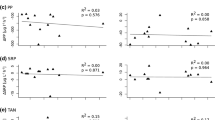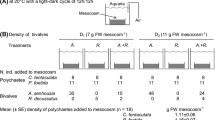Abstract
The purpose of the current study was to evaluate the role of visible light during trophic transfer of the essential metalloid, selenium (Se) from sediments by way of the microalgae Phaeodactylum tricornutum to bivalves. Initial experiments compared uptake of Se with algal cell number after deposit-feeding (Tellina deltoidalis) and filter-feeding (Soletellina alba) bivalves were exposed for 12 days under 16:8 h light:dark and 24-hour dark regimes to sediments amended with Se (17 mg/kg dry weight). Comparisons of filter-feeding with deposit-feeding organisms indicated >2-fold higher body burdens in the deposit-feeding organisms after 12 days. Darkness failed to significantly and consistently diminish algal cell densities. However, general trends indicated a decrease of pelagic algal numbers in +Se/dark treatments during the 12-day exposure. To determine whether time-dependent patterns were present in the uptake of Se by the deposit-feeding species, a second experiment was conducted using Se-laden sediments under light and dark conditions. Algal cell counts were measured and Se concentrations determined in animals sampled at days 0, 3, 6, 9, and 12. Deposit-feeding animals maintained in the dark accumulated, Se more rapidly than animals on light to dark cycles until 12 days at which time no significant differences were observed between treatments. Concentrations of Se in tissues of deposit-feeding bivalves were not directly related to algal cell density in lighted or dark chambers. These results indicate that pelagic microalgae may only play a key role in Se uptake during early hours of exposure, and feeding behavior may be a more important factor in deposite-feeding bivalves.


Similar content being viewed by others

References
Adams MS, Stauber JL (2004) Development of a whole-sediment toxicity test using a benthic marine microalga. Environ Toxicol Chem 23:1957–1968
Baines SB, Fisher NS (2001) Interspecific differences in the biocentration of selenite by phytoplankton and their ecological implications. Mar Ecol Progr Ser 213:1–12
Baldwin S, Deaker M, Maher WA (1994) Low volume microwave digestion of marine biological tissues for the measurement of trace elements. Analyst 119:1701–1704
Barwick M, Maher WA (2003) Biotransference and biomagnification of selenium, copper, cadmium, zinc, arsenic and lead in a temperate seagrass ecosystem from Lake Macquarie Estuary, NSW, Australia. Mar Environ Res 56:471–502
Cutter GA (1989) The estuarine behavior of selenium in San Francisco Bay. Estuarine Coast Shelf Sci 28:13–34
Eisler R (2000) Selenium. In: Handbook of chemical risk assessment: Health hazards to humans, plants, and animals. Boca Raton, FL, CRC, pp 1649–1705.
Fan W-M, Teh SJ, Hinton DE, Higashi RM (2002) Selenium biotransformations into proteinaceous forms by foodweb organisms of selenium-laden drainage waters in California. Aquat Toxicol 57:65–84
Guillard RRL, Ryther JH (1962) Studies of marine plankktonic diatoms I Cyclotella nana and Detonula confervaceae Hustedt (Cleve) Gran. Can J Microbiol 8:229–239
Hamilton SJ (2004) Review of selenium toxicity in the aquatic food chain. Sci Total Environ 326:1–31
Hu MH, Yang YP, Martin JM, Yin K, Harrison PJ (1997) Preferencial uptake of Se (IV) over Se (VI) and the production of dissolved organic Se by marine phyotplankton. Mar Environ Research 44:225–231
Jung RF, Batley GE (2004) Freezing of sediments inapproprite for pore water selenium analysis. Mar Poll Bull 49:295–298
Lemly AD (2002) Selenium assessment in aquatic ecosystems—A guide for hazard evaluation and water quality criteria. New York, NY, Springer-Verlag
Luoma SN, Johns C, Fisher NS, Steinberg NA, Oremland RS, et al. (1992) Determination of selenium bioavailability to a benthic bivalve from particulate and solute pathways. Environ Sci Technol 26:485–491
Maier KJ, Knight AW (1994) Ecotoxicology of selenium in freshwater systems. Rev Environ Contam Toxicol 134:31–48
Masscheleyn PH, Delaune RD, Patrick WH (1990) Transformations of selenium as affected by sediment oxidation-reduction potential and pH. Environ Sci Technol 24:91–96
Masscheleyn PH, Delaune RD, Patrick WH (1991) Biogeochemical behaviour of selenium in anoxic soils and sediments an equilibrium thermodynamic approach. J Environ Sci Health A Environ Sci Eng Toxic Hazard Subst Control 26A:555–573
Masscheleyn PH, Patrick WH (1993) Biogeochemical prosesses affecting selenium cycling in wetlands. Environ Toxicol Chem 12:2235–2243
Peters GM, Maher WA, Krikowa F, Roach AC, Jeswani HK, Barford JP, et al. (1999) Selenium in sediments, pore waters, and benthic infauna of Lake Macquarie, New South Wales, Australia. Mar Environ Res 47:491–508
Schlekat CE, Lee BG, Luoma SN (2002) Assimiliation of selenium from phytoplankton by three benthic invertebrates: Effect of phytoplankton species. Mar Ecol Progr Ser 237:79–85
Simpson SL, Angel BM, Jolley DF (2004) Metal equilibration in laboratory-contaminated (spiked) sediments used for the development of whole-sediment toxicity tests. Chemosphere 54:597–609
Vandermeulen J, Foda A (1988) Cycling of selenite and selenate in marine-phytoplankton. Mar Biol 98:115–123
Wang WX, Fisher NS, Luoma SN (1995) Assimilation of trace elements ingested by the mussel Mytilius edulis: Effects of algal food abundance. Mar Ecol Progr Ser 129:165–176
Wang WX, Fisher NS, Luoma SN (1996) Kinetic determinations of trace element bioaccumulation in the mussel Mytilus edulis. Mar Ecol Prog Ser 140:91–113
Wang WX, Stupakoff I, Fisher NS (1999) Bioavailability of dissolved and sediment-bound metals to a marine deposit-feeding polychaete. Mar Ecol Progr Ser 178:281–293
Willan RC (1998) Superfamily tellinoidea. In: Beesley PL, Ross GJB, Wells A (eds) Mollusca: The southern synthesis. Fauna of australia. Volume 5, Part B. CSIRO Publishing, Melbourne, Australia, pp342–348
Wrench JJ (1978) Selenium metabolism in marine phtoplankters Tetraselmis tetrathele and Dunaliella minuta. Mar Biol 49:231–236
Zhang GH, Hu MH, Huang YP (1990) Se uptake and accumulation in marine phyotplankton and transfer of Se to the clam Puditapes philippnarum. Mar Environ Res 30:179–190
Acknowledgment
The investigators thank the staff of CSIRO for their assistance in sediment collections, lead author rescue, and animal maintenance.
Author information
Authors and Affiliations
Corresponding author
Rights and permissions
About this article
Cite this article
Schlenk, D., Batley, G., King, C. et al. Effects of Light on Microalgae Concentrations and Selenium Uptake in Bivalves Exposed to Selenium-Amended Sediments. Arch Environ Contam Toxicol 53, 365–370 (2007). https://doi.org/10.1007/s00244-006-0248-3
Received:
Accepted:
Published:
Issue Date:
DOI: https://doi.org/10.1007/s00244-006-0248-3



